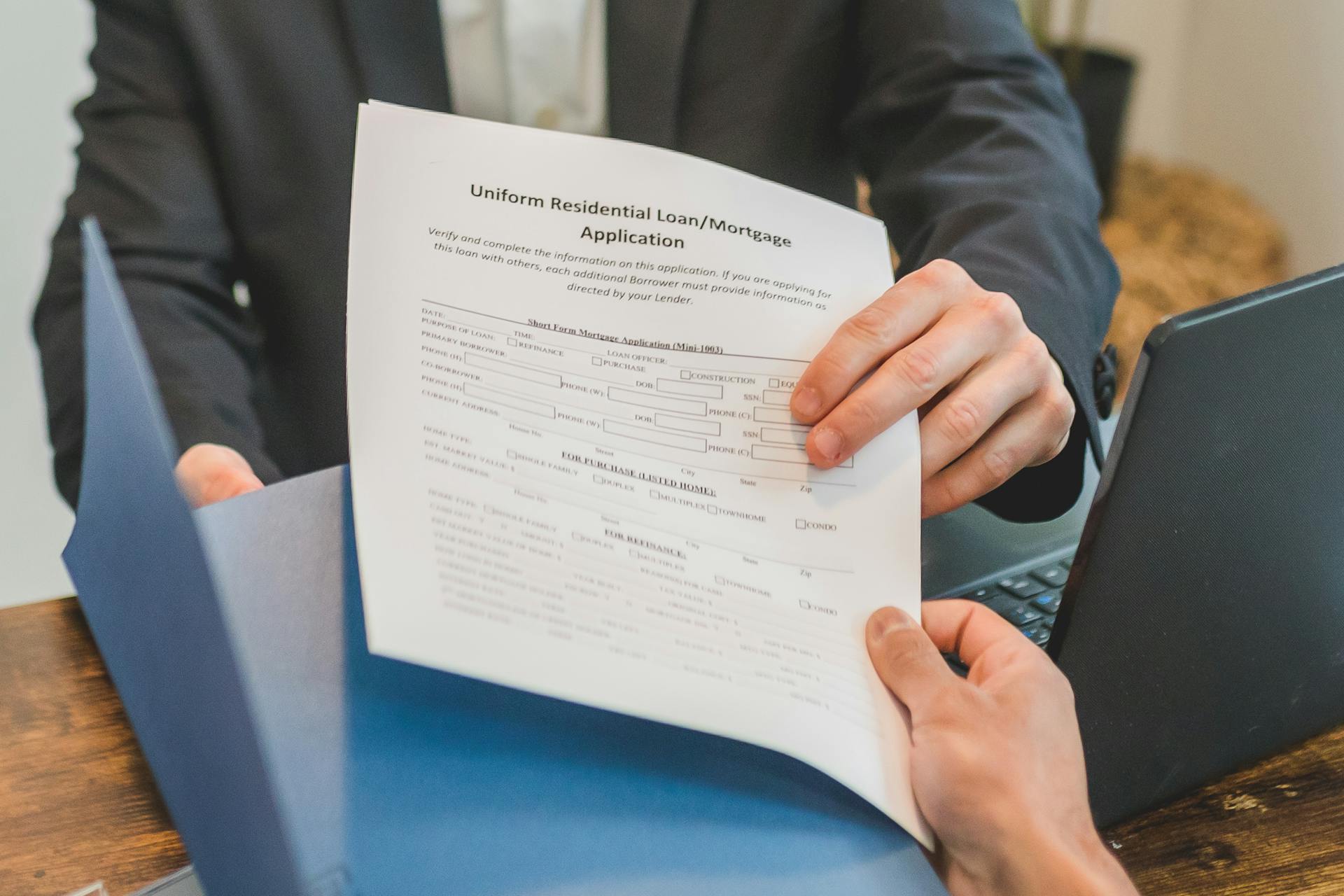
FHA manual underwrite guidelines can be a bit overwhelming, but understanding them is crucial for getting approved for an FHA loan. This process is used when a lender cannot make a decision based on the FHA automated underwriting system.
FHA manual underwrite guidelines require a thorough review of the borrower's credit history, income, and employment. The lender will also assess the borrower's debt-to-income ratio and credit score.
Manual underwriting involves a more hands-on approach, where the lender reviews the application and makes a decision based on their own discretion. This process can be time-consuming and may require additional documentation from the borrower.
In some cases, manual underwriting may be required due to incomplete or missing information in the credit report, or if the borrower has a non-traditional income or employment history.
Worth a look: Homeowners Insurance Underwriting Process
FHA Manual Underwrite Guidelines
FHA manual underwrite guidelines are used when a borrower doesn't qualify for an automated underwrite. The lender must use their own judgment to determine the borrower's creditworthiness.
A manual underwrite can be triggered by a credit score below 620, a high debt-to-income ratio, or a recent bankruptcy. This process involves reviewing the borrower's credit history, income, and employment history to determine their creditworthiness.
The lender must also consider the borrower's credit history, including any past-due accounts, collections, or bankruptcies.
What Is FHA
The Federal Housing Administration, or FHA, is a government agency that provides mortgage insurance to borrowers. FHA manual underwriting is a process that allows borrowers to qualify for a mortgage despite having unique circumstances.
FHA manual underwriting mortgage process can be more time-consuming and labor-intensive than automatic underwriting. Borrowers with low credit scores, limited credit history, or inconsistent income may require manual underwriting to determine their eligibility.
The FHA manual underwriting process involves a human underwriter reviewing a borrower's financial and credit history, employment, and assets manually. Borrowers who meet certain criteria, such as having a credit score below the minimum required for automatic underwriting, may be eligible for manual underwriting.
To be eligible for manual underwriting, borrowers may have limited credit history or non-traditional sources of income, such as self-employment or irregular payment schedules. Borrowers who have experienced financial hardships, such as bankruptcy, foreclosure, or short sales, may also require manual underwriting to determine their eligibility.
You might like: Walmart Trucks Automatic
Conditional Approval
Conditional Approval is a crucial part of the FHA manual underwriting process. You will receive conditional approval if the underwriter determines that you meet the FHA manual underwriting guidelines.
This means you can move forward with the loan, but under certain stipulations. For example, you may need to furnish extra paperwork or fulfill precise criteria.
Conditional approval is a good sign that you're on the right track, but it's essential to understand what's required to finalize your loan.
What Is Insurance?
Insurance is a crucial aspect of FHA manual underwrite guidelines. It helps protect lenders from potential losses in case a borrower defaults on the loan.
In manual underwriting, lenders may require additional insurance to mitigate risks associated with borrowers who have low credit scores or insufficient credit history.
Manual underwriting allows lenders to make informed decisions about insurance requirements for each borrower, taking into account their individual circumstances.
Borrowers who have a low credit score or insufficient credit history may be required to pay a higher premium for insurance, which can impact their overall mortgage costs.
Debt-to-Income Ratio (DTI)
The debt-to-income ratio, or DTI, is a crucial factor in FHA manual underwriting. It's the percentage of your monthly gross income that goes towards paying debts, including credit cards, car loans, student loans, and other obligations.
FHA manual underwriting allows for a maximum front-end DTI of 40% and a back-end DTI of 50% with two compensating factors. This is lower than the automated underwriting system, which has a maximum front-end DTI of 46.9% and a back-end DTI of 56.9%.
The number of compensating factors you have determines your maximum DTI. With no compensating factors, the maximum front-end DTI is 31% and the back-end DTI is 43%. With one compensating factor, the maximum front-end DTI is 37% and the back-end DTI is 47%.
To qualify for manual underwriting, you must provide documentation of all your debts and income. This includes recent pay stubs, W-2 forms, tax returns, and proof of employment. Some lenders may have more stringent requirements, so it's essential to check with your lender.
Your lender will assess your ability to handle the proposed mortgage payment based on your income and existing debts. They'll consider your credit report and payment history, as well as your assets and savings.
If this caught your attention, see: Manual Check Payment in Sap
Compensating Factors Determine DTI
Compensating factors play a huge role in determining your debt-to-income ratio on manual underwriting. FHA Manual Underwriting DTI Guidelines depend on borrowers' compensating factors.
If you have no compensating factors, the maximum front-end DTI is 31% and 43% back-end DTI. Borrowers with one compensating factor can qualify for a higher DTI of 37% front-end and 47% back-end.
With two compensating factors, the maximum front-end DTI is 40% and back-end DTI is 50%. This shows how important it is to have a strong case for manual underwriting.
To qualify for manual underwriting, you must provide detailed documentation of your assets and savings, such as bank statements and investment account statements. This helps lenders evaluate your ability to save and manage your finances.
A detailed credit report, including payment history, is also required. Lenders use this information to evaluate your creditworthiness and ability to make timely payments.
A different take: Do Underwriters Check Bank Statements before Closing
Loan Application and Approval
The loan application process is a crucial step in the FHA manual underwrite guidelines. You must complete the loan application with the lender, providing comprehensive details about your financial status, work history, and the property you plan to buy.
This includes filling out the FHA loan application, which requires you to provide a lot of information about yourself and the property.
For your interest: Fha Property Flipping
Loan Requirements and Documentation
The minimum credit score for FHA manual underwriting is 500, although lenders may have higher requirements.
To qualify for manual underwriting, borrowers typically need to provide extensive documentation, including proof of employment and income. This can include recent pay stubs, W-2 forms, and tax returns.
Self-employed borrowers must provide additional documentation, such as profit and loss statements and business tax returns. Lenders may also contact employers directly to verify employment status.
Documentation Required
To get approved for a loan, you'll need to provide proof of your employment and income, which can include recent pay stubs, W-2 forms, and tax returns.
Lenders may also contact your employer directly to verify your employment status, so it's essential to be prepared for this step.
Self-employed borrowers need to provide additional documentation, such as profit and loss statements and business tax returns, to show their income and financial stability.
These documents will give lenders a detailed picture of your financial situation, helping them make an informed decision about your loan application.
Additional reading: Financial Ratios Are Guidelines for
Verification of Rent
Verification of rent is a crucial part of the loan process, especially on manual underwriting for FHA loans. Verification of rent is normally required by most lenders.
To prove timely payments to the landlord, you'll need to provide 12 months of canceled checks or 12 months of bank statements reflecting the payment. Cash rental payment is not a valid form of rental verification.
A verification of rent form needs to be completed, dated, and signed by the landlord, and you'll also need to provide proof of payment via canceled checks or bank statements. Paying cash for rent with a rental receipt is not a valid form of verification of rent.
If you're living rent-free with family to save money for the down payment, FHA Bad Credit Lenders will waive verification of rent on manual underwrites. A living rent-free with family form needs to be completed by the landlord, signed, and dated.
For another approach, see: Fha Second Mortgage for down Payment
Verification of rent shows the lender you have a history of paying rent on time, which is essential for manual underwriting. The rent needs to have been paid timely for the past 12 months.
Rental verification is important because it shows the lender the homebuyer has a history of payment rent, which reduces the risk of default. One 30-day rental payment voids verification of rent.
The smaller the gap between the proposed housing payment and the rent payment, the lower the payment shock. The lower the payment shock, the stronger the compensating factor.
Discover more: Fha Loan Amount down Payment
Mortgage Eligibility and Benefits
FHA manual underwriting mortgages offer flexible approval, considering individual circumstances to give a more holistic view of the borrower's ability to repay the loan.
Borrowers can strengthen their manual underwriting application by demonstrating compensating factors, such as a larger down payment, significant cash reserves, or stable employment.
Housing counseling is required for borrowers with lower credit scores, providing valuable financial education and improving their chances of approval.
With a good payment history, borrowers who initially obtained an FHA manual underwriting mortgage may be eligible for a streamlined refinance.
Mortgage Eligibility Criteria
To get a mortgage, you'll need to meet certain eligibility criteria. Your credit score plays a significant role, and if it's below 580, you may need to go through manual underwriting. A higher down payment may also be necessary in this case.
FHA loans typically require a maximum debt-to-income ratio of 43%, but manual underwriting can make exceptions for borrowers with compensating factors.
Borrowers with limited credit history or non-traditional credit sources may need to go through manual underwriting to assess their creditworthiness.
If you've had extenuating circumstances, such as a history of responsible rent payments or job stability, manual underwriting can consider these factors to offset credit challenges.
Previous FHA loan defaults may require manual underwriting to evaluate your eligibility for a new loan.
Benefits of Mortgage:
The benefits of mortgage options like FHA manual underwriting are numerous. Borrowers who don't meet the standard FHA criteria can still get approved with flexible approval.
Manual underwriting considers individual circumstances, giving a more holistic view of the applicant's ability to repay the loan. This means that borrowers who have unique financial situations can still qualify.
Compensating factors can strengthen a manual underwriting application. A larger down payment, significant cash reserves, or stable employment can all be beneficial.
Housing counseling is required for borrowers with lower credit scores, but it can provide valuable financial education and improve their chances of approval. This education can help borrowers make informed decisions about their finances.
Borrowers who initially obtained an FHA manual underwriting mortgage may be eligible for a streamlined refinance if they establish a good payment history. This can make refinancing easier and more affordable.
Mortgage Process and Lender Selection
The mortgage process can be overwhelming, but understanding the basics can make a big difference. To start, you'll need to decide on a lender, and it's essential to choose one that's FHA-approved.
When selecting a lender, consider their reputation, fees, and interest rates. You can check the lender's website or contact them directly to ask about their FHA loan options and requirements.
A lender's experience with FHA loans can make a significant difference in the underwriting process. For example, lenders who are familiar with FHA manual underwrite guidelines can help you navigate the process more efficiently.
Related reading: Which of the following Describes the Securities Underwriting Process
What Is the Mortgage Process
The mortgage process can be a complex and intimidating experience, but understanding the basics can help you navigate it with ease. You'll need to decide whether to apply for a fixed-rate or adjustable-rate mortgage.
A fixed-rate mortgage has a interest rate that remains the same for the entire loan term, typically 15 or 30 years. This can provide stability and predictability in your monthly payments.
The mortgage application process typically begins with pre-approval, where you provide financial information to a lender to determine how much they're willing to lend you. You'll need to provide documentation such as pay stubs, bank statements, and tax returns.
You can apply for a mortgage through a bank, credit union, or online lender. Online lenders often have more flexible requirements and faster processing times.
Explore further: Cyber Insurance Underwriting
Select an Approved Lender
Selecting an approved lender is a crucial step in the mortgage process. Not all lenders provide manual underwriting services, so you may need to inquire and find one that specializes in this process.
To get started, you'll need to choose an FHA-approved lender. This ensures that the lender has met the Federal Housing Administration's standards for offering FHA loans.
Not all lenders offer FHA loans, so it's essential to select one that does.
A different take: What Happens after an Underwriter Approves a Loan
Toughened Standards and Review
You may need to explain any derogatory credit events, such as late payments or collections.
The lender will review your credit report and history carefully if you're required to go through manual underwriting.
Your credit score being below the FHA's standard minimum, typically 580, can trigger manual underwriting.
You'll need to be prepared to provide detailed explanations for any negative marks on your credit report.
This careful review is a key part of the manual underwriting process.
See what others are reading: What Is an Underwriting Review for Car Insurance
Frequently Asked Questions
What is the manual underwrite ratio for FHA?
The standard manual underwrite FHA ratio is 31/43, which includes a 31% housing ratio and a 43% total debt-to-income ratio. Borrowers with no credit score or less than 580 credit score are limited to this ratio.
How many months of reserves are needed for an FHA manual underwrite?
For FHA manual underwrites, at least one month of reserves is required.
What is the process behind manual underwriting?
Manual underwriting involves a thorough review of your financial documents, including bank statements and tax documents, to assess your creditworthiness and property eligibility. This detailed process helps lenders make informed decisions about your loan application.
Sources
- https://gcamortgage.com/fha-manual-underwriting-dti-guidelines/
- https://fhabadcreditlenders.com/fha-manual-underwriting/
- https://mortgagelendersforbadcredit.com/fha-manual-underwriting/
- https://gcamortgage.com/fha-manual-underwriting-mortgage-guidelines/
- https://www.mortgagenewsdaily.com/news/12112013-underwriting-standards
Featured Images: pexels.com


